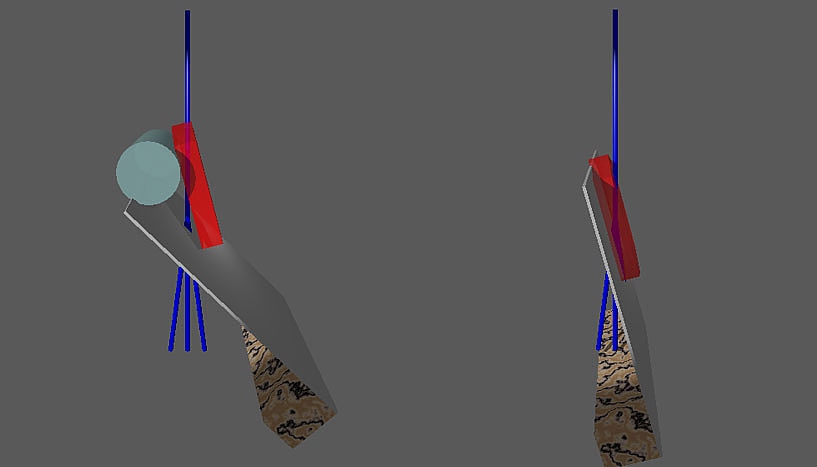Jul 29 2019
Scientists have attempted to use a technique for a complete 3D analysis of submicron crystals.
 A nylon fiber (light blue), deposited on the carbon carrier (grey), lifts up the crystal (red). This way, the crystal’s side face becomes visible to the electron beam (blue). Without the fiber (right figure), the crystal lies flat on the carbon and the metal bar of the sample holder (marbled) occludes the signal. (Image credit: Tim Grüne)
A nylon fiber (light blue), deposited on the carbon carrier (grey), lifts up the crystal (red). This way, the crystal’s side face becomes visible to the electron beam (blue). Without the fiber (right figure), the crystal lies flat on the carbon and the metal bar of the sample holder (marbled) occludes the signal. (Image credit: Tim Grüne)
The requirement for a 3D analysis of crystal structures is a complete 3D view of the crystals. Crystals as small as powder, with sides less than 1 µm, could be analyzed only with electron radiation. It is technically not possible to have a complete 360° view of a single crystal using electron crystallography.
A group of scientists led by Tim Gruene from the Faculty of Chemistry at the University of Vienna altered the holder of the tiny crystals to positively have a complete view. Currently, their findings have been presented in Nature Communications.
Usually, X-rays are used by crystallographers to investigate their samples. However, size is an important factor for the analysis of X-ray structure: Crystals with sides less than 50–100 µm are too small to generate a quantifiable signal.
Electron crystallography is a quite recent development. We demonstrated to our chemist colleagues that we can analyse crystals with edges less than 1 micrometre—this includes many crystals which escape 3D structure determination so far.
Tim Grüne, Department of Inorganic Chemistry and Head of the Centre for X-ray Structure Analysis, University of Vienna
Limited View
The interaction of electrons with matter is very strong compared to that of X-rays. Characteristic diffraction images are generated by submicrometer-sized crystals once they are irradiated with electrons. Although these offer structure analysis data, the sample holder prevents a complete 360° rotation.
At present, there is only one rotational axis available, and the metal bars that are essential for stabilizing the delicate sample cannot be penetrated by the electrons. Only a rotation of approximately 75° is feasible in either direction.
“This gives us a maximum of 300 degree valuable data, which leads to an erroneous structural analysis,” remarked Grüne. He and his coworkers from ETH Zurich and PSI have presented a neat trick to solve the issue.
Their study has offered two solutions to avoid the issue. First, they prepared the sample holder to view crystals from all sides, and the presence of several crystals in one sample holder was very much sufficient to complete the data and provide an exact 3D view.
Tricking the Carrier
An ultrathin carbon layer, the carrier material, is disturbed by a simple, readily available procedure that involves using a fine brush.
As a consequence, individual segments of the carbon layer curl up—like when you touch the fruit of touch-me-not. The crystals stick to the curls and achieve a random orientation. One can comfortably select several individual crystals from very different views.
Tim Grüne, Department of Inorganic Chemistry and Head of the Centre for X-ray Structure Analysis, University of Vienna
The second solution includes the carbon carrier with nylon fibers. “The surfaces resembles a forest covered chaotically with tree logs,” stated Tim Grüne. This again led to different arbitrary orientations of the crystals once they are deposited on the sample holder. The nylon fibers, however, are collected by electrospinning, which needs a further apparatus and is somewhat more complicated than stroking it with a brush.
“Neat and Simple”
Both procedures offer datasets from the crystals with a full 3D structural analysis. This kind of combining datasets is usually used in protein crystallography, but much less in chemical crystallography.
Our work exploited the fact that data merging works likewise for chemical compounds as it does for proteins. We only needed 5 crystals in both cases to complete the data. We did not avoid the problem, but demonstrated how to reveal the hidden faces of the crystals to the electron beam. Both solutions are surprisingly simple and can be realised without much effort.
Tim Grüne, Department of Inorganic Chemistry and Head of the Centre for X-ray Structure Analysis, University of Vienna